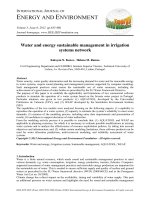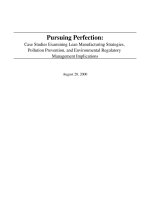cyber security and business continuity management
Bạn đang xem bản rút gọn của tài liệu. Xem và tải ngay bản đầy đủ của tài liệu tại đây (2.51 MB, 36 trang )
www.pwc.com/ca
EPICC
Cyber Security and
Business Continuity
Management
October 2016
Meet the team
Cyber security is top of mind for many organizations, and we’re
seeing a large number undertaking initiatives to address risk. For
some, these initiatives lead to tailor-made processes and controls to
address risk.
Ed Matley
Director, Risk Assurance
Edward is a Director in PwC’s
Risk Assurance practice, based in
Vancouver. He leads our Business
Resilience practice in Western
Canada.
Cybersecurity and Business Continuity Management
PwC
Marie Lavoie Dufort
Associate, Risk Assurance
Marie is an Associate in Vancouver’s
Risk Assurance practice. She focuses
on Business Resilience projects, with
a particular focus on crisis
management and communication.
October 2016
2
Our interpretation of Cybersecurity
Definition:
Cyber security is not just about technology
and computers. It involves people,
information systems, processes, culture and
physical surroundings as well as
technology.
It aims to create a secure environment
where businesses can remain resilient in
the event of a cyber breach.
Cybersecurity and Business Continuity Management
PricewaterhouseCoopers LLP
October 2016
3
Cybersecurity and IT security are
synonymous. They both relate to
securing an organization’s IT
systems.
True
Cybersecurity and Business Continuity Management
PwC
False
October 2016
4
1. Cybersecurity is achieved by
securing digital assets with the use
of robust firewalls to prevent
potential attacks.
True
Cybersecurity and Business Continuity Management
PwC
False
October 2016
5
Cybersecurity is the responsibility
of the CIO or Head of IT in an
organization.
True
Cybersecurity and Business Continuity Management
PwC
False
October 2016
6
Cyber attacks are caused by
individual hackers who want to steal
valuable information.
True
Cybersecurity and Business Continuity Management
PwC
False
October 2016
7
What incidents are we seeing in Vancouver?
E-mail Phishing / Spear Phishing
Email ‘phishing’ attacks regarding payment requests have impacted numerous
clients in recent months resulting in millions of dollars of financial fraud.
Malicious Software
Laptops, desktops and handheld devices are being hacked using malicious
software resulting in exfiltration of sensitive and confidential corporate
documents / intellectual property.
Internal Attacks
Disgruntled employees sabotaging information systems impacting the
company’s business operations.
Cybersecurity and Business Continuity Management
PricewaterhouseCoopers LLP
October 2016
8
Recent global incidents
Russians behind JPMorgan Cyber attack:
‘It scared the pants off many people’
Washington Times, October 2014
PricewaterhouseCoopers LLP
JP Morgan= about 76 million households
affected
Home Depot = about 56 million customer
debit and credit card info compromised
Ebay = 233 million user information is
compromised
9
Organizations today face four main types of cyber
adversaries
Adversary
Nation State
Organized
Crime
Hacktivists
Insiders
PricewaterhouseCoopers LLP
Targets
Motives
Impact
• Economic, political,
and/or military advantage
• Trade secrets
• Sensitive business
information
• M&A information
• Critical financial systems
• Loss of competitive
advantage
• Regulatory inquiry/penalty
• Disruption to critical
infrastructure
• Immediate financial gain
• Collect information for future
financial gains
• Financial / payment systems
• Personally identifiable
information
• Payment card information
• Protected health information
• Regulatory inquiry/penalty
• Consumer and shareholder
lawsuits
• Brand and reputation
• Loss of consumer confidence
• Influence political and /or
social change
• Pressure business to change
their practices
• Corporate secrets
• Sensitive business information
• Critical financial systems
• Disruption of business
activities
• Brand and reputation
• Loss of consumer confidence
• Personal advantage,
monetary gain
• Professional revenge
• Patriotism
• Bribery or coercion
•
•
•
•
•
Sales, deals, market strategies
Corporate secrets
Business operations
Personnel information
Administrative credentials
•
•
•
•
Trade secret disclosure
Operational disruption
Brand and reputation
Loss of consumer confidence
10
The Global State of Information Security® Survey
2016
10,000
Respondents
17
Industries represented
Reported annual revenues
•
51% C-suite level
Top 5
•
34% at least US$1B
•
15% Director level
• 22% Technology
•
48% US$25 to $999M
•
34% Other (e.g. Manager,
Analyst, etc.)
• 10% Financial Services
•
26% less than US$100M
• 8% Consulting/Prof. Services
•
3% non-profit
•
39% Business and 61% IT
(18% increase compared to
2014)
• 7% Engineering/ Construction
• 7% Consumer Products &
Retail
Cybersecurity and Business Continuity Management
PwC
October 2016
11
The Global State of Information Security® Survey
2016
2016 Canadian insights at a glance
160% increase in
detected
incidents in
Canada (over
2014)
Incidents attributed
to foreign nationstates increased the
most ( up 67% over
2014) while
employees continue
to be the most cited
source of incidents
(66%)
Customer
records continue
to be the most
targeted data
(36%)
Cybersecurity and Business Continuity Management
PwC
Attacks on IoT
devices and
systems are on
the rise
Security spending
increased by 82%
over 2014, currently
at 5% of IT spend
Average financial
loss due to detected
incidents is $1M
(18% decrease from
2014)
October 2016
12
The Global State of Information Security® Survey
2016
65% 58%
50% 54%
Have an overall
information
security strategy
Have a CISO in
charge of security
57% 53%
50% 49%
Employee training
and awareness
programs
Conduct threat
assessments
55% 52%
54% 48%
Have security
baselines / standards
for third parties
Active monitoring
analysis of security
intelligence
Cybersecurity and Business Continuity Management
PwC
October 2016
13
Risk-based frameworks can help organizations
design, measure and monitor progress towards an
improved cyber program
NIST Cybersecurity Framework
41% 35%
ISO27001
29% 40%
SANS Critical Controls
24% 28%
ISF Standard of Good Practice
22% 26%
Other
17% 18%
None
8%
Do not know
13% 11%
Cybersecurity and Business Continuity Management
PwC
8%
October 2016
14
Risk-based frameworks can help organizations
design, measure and monitor progress towards an
improved cyber program
NIST Cybersecurity
Framework
a voluntary framework –
based on existing
standards, guidelines, and
practices - for reducing
cyber risks to critical
infrastructure.
ISO 27001
The ISO 27000 family of
standards helps
organizations keep
information assets secure.
SANS Critical Controls
The CIS Critical Security
Controls are a recommended
set of actions for cyber defense
that provide specific and
actionable ways to stop
today's most pervasive and
dangerous attacks. A principle
benefit of the Controls is that
they prioritize and focus a
smaller number of actions
with high pay-off results
Cybersecurity and Business Continuity Management
PwC
ISF Standard of
Good Practice
The ISF Standard of
Good Practice for
Information Security is
the most comprehensive
information security
standard in the world,
providing more coverage
of topics than ISO
October 2016
15
Risk-based frameworks and controls
NIST Cybersecurity
Framework
• Response plans
(Incident Response and
Business Continuity)
SANS Critical Controls
• Incident response and
management
ISO 27001
• Recovery plans (Incident
Recovery and Disaster
Recovery)
• Risk Assessment
• Information security
aspects of business
continuity
management
• Information security
continuity
ISF Standard of
Good Practice
• Business continuity
strategy
• Business Continuity
Program
• Resilience
• Crisis Management
• Business Continuity
Planning
• Business Continuity
Arrangements
• Business Continuity
Testing
Cybersecurity and Business Continuity Management
PwC
October 2016
16
Integrating Cybersecurity and BCM
Cybersecurity and Business Continuity Management
PwC
October 2016
17
What is BCM?
A holistic management process that identifies potential threats to an
organization and the impacts to business operations those threats, if
realized, might cause, and which provides a framework for building
organizational resilience wit the capability of an effective response that
safeguards the interests of its key stakeholders, reputation, brand and
value-creating activities.
Cybersecurity and Business Continuity Management
PricewaterhouseCoopers LLP
October 2016
18
The Business Continuity Management Lifecycle
Shows the stages of activity that an
organization moves through and
repeats with the overall aim of
improving organizational resilience
Improving
organizational
resilience
Cybersecurity and Business Continuity Management
PricewaterhouseCoopers LLP
October 2016
19
Current developments in BCM
WEF Global Risk Report
respondents were asked to
select the three global risks
that they believe are the most
likely to occur in North
America
Cyber attacks are top of
mind
Cybersecurity and Business Continuity Management
PricewaterhouseCoopers LLP
October 2016
20
Current developments in BCM
Cybersecurity and Business Continuity Management
PricewaterhouseCoopers LLP
October 2016
21
Pros and cons
-
+
•
Clarity
•
Efficiency
•
Level of detail
•
Risk Management
•
Organizational silos
Cybersecurity and Business Continuity Management
PwC
October 2016
22
Analysis
Objective:
1
Business impact analysis
Identify & prioritize most time sensitive business activities
2
Continuity requirements
What resources does our organization need
3
Risk assessment
Limit the impact of disruptions on an organizations key services
Cybersecurity and Business Continuity Management
PricewaterhouseCoopers LLP
October 2016
23
Analysis
Integrating cybersecurity and BCM
1
Analysis
•
•
•
•
Identification of, “crown jewels,” information assets
Engaging IT resources early
Performing an explicit cyber risk assessment
Identification of operational controls gaps
Cybersecurity and Business Continuity Management
PricewaterhouseCoopers LLP
October 2016
24
Design
Objective:
Identifies and selects appropriate tactics to determine how
continuity and recovery from disruptions will be achieved.
Cybersecurity and Business Continuity Management
PricewaterhouseCoopers LLP
October 2016
25









